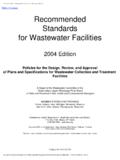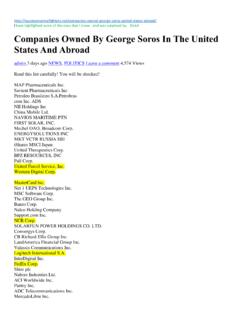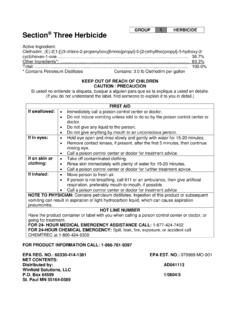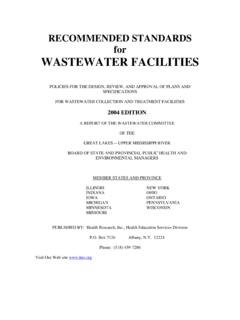Transcription of Marine Industry Learning Guide - NAMEPA
1 Marine IndustryLearning GuideInteractive lessons for educators, seafarers, and the public2 Marine Industry Learning Guide OF CONTENTS 3 Introduction/BackgroundINTRODUCTORY (GRADES K-5)4 What Floats Your Boat? Introduction to the parts of a boat and their uses6 Types of Ships Identifying the types of vessels and their uses8 Ports The role of ports in the Marine industryINTERMEDIATE (GRADES 6-8)10 History of Marine Transit A time line of the Marine industry12 Canals and Waterways The history of canals and their importance in shipping14 Shipping and Its Role in Global Society How a ship transports cargo to its destinationADVANCED (GRADES 8-12)16 Nautical Charts and GPS The importance of navigation tools in the Marine industry19 Maritime Regulations Regulations that safeguard our waters21 Careers in the Maritime Industry Career paths in the Marine industryADDITIONAL RESOURCES22 Adopt A Ship Connecting your classroom to the Marine industry23 An Overview of Regulations Relating to the International Shipping Industry24 Cargo Match Game Handout (Types of Ships)
2 26 Glossary28 AcknowledgmentsP Marine Industry Learning Guide 3 Ninety percent (90%) of all consumer goods have spent some part of their journey on a ship, making the Marine Industry one of the primary drivers of globalization and trade. Vessels move cargo around the world in far greater volumes more efficiently, safely and with a lower environmental impact than any other mode of transportation. Ships transport all sorts of commodities such as grains and fruit, liquefied natural gas (LNG), coal and petroleum oil for energy production, raw materials, clothing, cars and electronics, and so much more. Ships are also popular for vacations; the cruise Industry alone carries millions of passengers and generates billions of dollars in revenue every year. Ferries provide terrific options for com-muting and help reduce road success of the Marine Industry is based on the supply and demand of goods from around the world.
3 Advances in technologies, such as the development of faster and lighter ships, the construction of canals, and im-provements in navigational systems have improved the overall operation of the Industry . These advancements have made it easier, more efficient and safer for crews, the environment, and ships to move the purposes of this Learning Guide , the Marine Industry is being defined to include any economic activity of or relating to the oceans, rivers, and the Great Lakes. This includes traditional maritime activities such as designing, constructing, manufacturing, supplying, maintaining vessels or parts, operating and managing shipping lines, or crewing ships. It can also include engaging in maritime law, brokerage services, insurance, customs services, fishing operations, Marine science, salvage operations and the operation of ports, shipyards, drydocks, and cruise lines.
4 Additionally, the exploration for and exploitation of both offshore renewable and nonre-newable energy sources are included in the Marine 's goals include increasing the public s awareness of the Marine Industry and the Industry 's dedication to the health and safety of its crew, the environment and its fleet. Through the use of this Guide , readers can learn to appreciate and understand the importance the Marine Industry and how the people working in it affect everyday lives. It may even spark a desire to become a part of this vibrant, global Industry ! Marine Industry Learning GUIDEINTRODUCTIONThe North American Marine Environment Protection Association ( NAMEPA ) is an independent, Marine Industry -led entity that engages Industry , regulators, environmental groups, educators and the public by promoting sound environmental practices. NAMEPA is a non-profit organization committed to Save Our Seas and preserving the Marine environment through educating seafarers, students and the public about the need, and strategies for, protecting global ocean easy-to-use Guide is designed to provide maximum flexibility for learners in both formal and informal settings.
5 It may be used as a standalone teaching tool, or to supplement lessons in other areas. This Guide includes information about the Marine Industry with useful lessons for students in grades K-12 with a focus on STEM (Science, Technology, Engineering, Mathematics) objectives and alignment to NGSS (Next Generation Science Standards).To access resources referenced in this Guide and for additional information, visit SAVE OUR SEAS 4 Marine Industry Learning Guide the left side of the ship when facing the bow. Rigging the lines that support the masts and move the a blade attached under the stern used for - types of:Jibs triangular sails at the front of the ship; attached to the sails rectangular sails that are placed square or perpendicular to the keel. Main sails the lowest sails the next level of sails above the main the back of the (pronounced t gallant) the third sail or set of sails from the bottom, above the the biggest sail at the stern of the heavy lines which hold up the masts from the sides of the vessel.
6 Starboard the right side of the vessel when facing the long pieces of wood used to support the sails and rigging. The bowsprit, masts, and yards are all horizontal spars that hold square Labeling a Ship PowerPoint2. Ship design challenge instructions3. Aluminum foil4. Popsicle sticks (20 per group )5. Uncooked pasta rigatoni or penne (20 per group )6. White glue (one per group )7. Masking tape (one per group )8. Pennies (40+)9. Medium to large sized tubs of water (1-3 gallons)BACKGROUNDA mazingly, over 50% of the global population lives within two miles of a body of water. That means ships are all around us! For thousands of years, ships have allowed us to enjoy the beauty of being on the water and adventure to new places. The first known floating vessels were used around 10,000 BC, but it wasn't until 3,000 BC that Egyptians and Mesopotamians started building rafts for trade and transport.
7 Ships have come a long way since then; modern ships are capable of traveling for thousands of miles with several tons of cargo. Buoyancy is the ability of an object to float based on its tendency to float or rise in liquid. An object that floats in water is positively buoyant, while an object that sinks is negatively buoyant. This is related to the object s mass and volume rela-tionship called its density. When an object is placed in water, a certain amount of water is displaced. The object will sink until the object displaces the amount of water that is equivalent to GRADE: K-5 TIME: 30-45 MINSUMMARYIn this lesson, students will be introduced to the parts of a ship and their correct names. Students will begin to understand the scientific principle of buoyancy and how the different parts of the ship are necessary to make the ship float. In the end, students will use the information obtained to create a ship out of alumi-num foil that is capable of floating and carrying a cargo.
8 OBJECTIVESS tudents will:1. Identify the parts of a ship and their proper Understand the basic scientific principle of Engineer a ship out of household materials based on scientific APPLICATIONSS cience, Engineering, and MathNGSS ALIGNMENTK-2-ETS1-2. Develop a simple sketch, drawing, or physical model to illustrate how the shape of an object helps it function as need-ed to solve a given Analyze data from tests of two objects designed to solve the same problem to compare the strengths and weak-nesses of how each Plan and conduct an investigation to describe and clas-sify different kinds of materials by their observable Analyze data obtained from testing different materials to determine which materials have the properties that are best suited for an intended large hook attached to the ship which is cast over-board and digs into the sea bed to keep the ship from the front of the spar attached at an angle to the bow of a ship, used to hold the ability of an object to float in a and aft from the bow to the stern; fore is towards the front.
9 Aft is towards the the main body of the ship. Keel the timber at the very bottom of the hull that runs from the bow to the stern; often called the ship s backbone. Line a sailor s word for a a large wooden spar used to hold up other spars and FLOATS YOUR BOAT?1 INTRODUCTION TO THE PARTS OF A BOAT AND THEIR USES Marine Industry Learning Guide 5 WHAT FLOATS YOUR BOAT?the object s mass. Boats and ships partly float and partly sink depending on their masses. For example, an object with a mass of 1 gram will displace 1 gram of water. If the object is less dense than the liquid it is placed in, it will float. However, if the object is denser than the liquid, it will sink. Since water has a high density, it is capable of holding a large weight like a cargo ship! Buoyancy is also related to the force of gravity pushing down on an object in water while a buoyant force acts upwards on the object, preventing it from capsizing.
10 Ships are also equipped with ballast water tanks to adjust the weight of the vessel at port by loading and unloading excess water. This keeps the vessel from floating or sinking too lesson will help students learn the parts of a ship and how they function to keep the vessel afloat. Students will gain an ap-preciation for the scientific principles that allow ships to float, and use that knowledge to design a ship to carry the most Engage/ElicitEvery activity has a specific set of vocabulary that goes along with it; the same holds true for the shipping Industry . Boating and sailing have a unique set of terms that allow the members of the crew and the passengers to communicate. This vocabulary will help you to better understand the maritime Industry . Introduce each word in the vocabulary by using the associated Parts of a Ship PowerPoint to clearly identify the parts of a students about their own personal experiences with a boat or ship.









